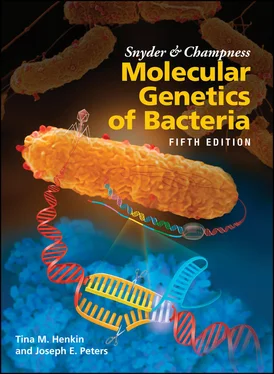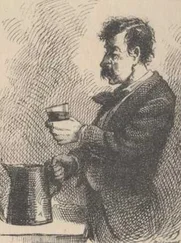Novobiocin and its more potent relative coumermycin bind to the GyrB subunit, which is involved in ATP binding. These antibiotics do not resemble ATP, but by binding to the gyrase they somehow prevent ATP cleavage, perhaps by changing the conformation of the enzyme. Mutants resistant to novobiocin have an altered gyrB gene.
The discussion of the replication and structure of the bacterial genome ignores the complexity of the sequences and the functions they encode. Advances in DNA-sequencing technologies are drastically reducing both the time it takes to sequence DNA and the cost of DNA sequencing. We are now at a time when determining the genomic sequence of a newly discovered bacterium is often one of the earliest steps in trying to fully characterize the functions of a new species. In addition, there are also a large number of studies where DNA from a particular environment or a consortium of organisms is chosen for DNA sequencing instead of that of a single organism derived from pure culture. Bacterial and archaeal genomes are in some ways more amenable to genome analysis than eukaryotic genomes because they are relatively small, ranging from ca. 0.5 megabases (Mb) for some obligate parasites to around 10 Mb for some free-living bacteria. They contain few introns and much less repetitive DNA than eukaryotic genomes. Chapter 13deals with ideas for how genomes are structured and the tools we use to study them.
1 DNA consists of two strands wrapped around each other in a double helix. Each strand consists of a chain of nucleotides held together by phosphates joining their deoxyribose sugars. Because the phosphate joins the third carbon of one sugar to the fifth carbon of the next sugar, the DNA strands have directionality, or polarity, and have distinct 5′ phosphate and 3′ hydroxyl ends. The two strands of DNA are antiparallel, so that the 5′ end of one is on the same end as the 3′ end of the other.
2 DNA is synthesized from the precursor deoxynucleoside triphosphates by DNA polymerase. The first phosphate of each nucleotide is attached to the 3′ hydroxyl of the next deoxynucleotide, giving off the terminal two phosphates to provide energy for the reaction.
3 DNA polymerases require both a primer and a template strand. The pairing of the bases between the incoming deoxynucleotide and the base on the template strand dictates which deoxynucleotide will be added at each step, with A always pairing with T and G always pairing with C. The DNA polymerase synthesizes DNA in the 5′-to-3′ direction, moving in the 3′-to-5′ direction on the template.
4 DNA polymerases cannot put down the first deoxynucleotide, so RNA is usually used to prime the synthesis of a new strand. Afterward, the RNA primer is removed and replaced by DNA, using upstream DNA as a primer. The use of RNA primers helps reduce errors by allowing editing.
5 DNA polymerase does not synthesize DNA by itself but needs other proteins to help it replicate DNA. These other proteins are helicases that separate the strands of the DNA, ligases to join two DNA pieces together, primases to synthesize RNA primers, and other accessory proteins to keep the DNA polymerase on the DNA and reduce errors.
6 Both strands of double-stranded DNA are replicated from the same end, so that the overall direction of DNA replication is from 5′ to 3′ on one strand and from 3′ to 5′ on the other strand. Because DNA polymerase can polymerize only in the 5′-to-3′ direction, it must replicate one strand in short pieces and ligate them afterward to form a continuous strand. The short pieces are called Okazaki fragments. The two DNA polymerases replicating the leading and lagging template strands remain bound to each other in a process called the trombone model of replication.
7 Lesions on DNA, proteins bound to DNA, and transcription can stall DNA replication. Primase can reinitiate replication to prevent the entire holoenzyme from stalling but leaving a gap that is repaired by other mechanisms. DNA helicases and other enzymes can be used to help DNA polymerase past bound proteins and to allow the polymerase to continue after it stalls from collisions with RNA polymerase.
8 The DNA in a bacterium that carries most of the genes is called the bacterial chromosome. The chromosome of most bacteria is a long, circular molecule that replicates in both directions from a unique origin of replication, oriC. Replication of the chromosomes initiates each time the cells reach a certain size. For fast-growing cells, new rounds of replication initiate before old ones are completed. This accounts for the fact that fast-growing cells have a higher DNA content than slowergrowing cells.
9 Chromosome replication terminates, and the two daughter DNAs separate, when the replication forks meet. In some bacteria, multiple ter sites that act as “one-way gates” delay movement of the replication forks on the chromosome. Proteins that bind to the ter sites that are inhibitors of the DnaB helicase stop replication at these sites.
10 To separate the daughter DNAs after replication, dimerized chromosomes, created by recombination between the daughter DNAs, are resolved by XerC and XerD, a site-specific recombination system that promotes recombination between the dif sites on the daughter chromosomes. The FtsK protein is a DNA translocase that promotes XerC-XerD recombination at dif sites to prevent dimerized chromosomal DNA from being guillotined by the forming septum. Topo IV decatenates the intertwined daughter DNAs by passing the double-stranded DNAs through each other, and its activity is also regulated temporally and spatially via an interaction with FtsK.
11 The daughter chromosomes are segregated by condensing the DNAs through supercoiling by DNA gyrase and by condensins that hold the DNA in large supercoiled loops.
12 The FtsZ protein forms a ring at the midpoint of the cell, attracting other proteins, which form the division septum.
13 The Min proteins prevent the formation of FtsZ rings anywhere in the cell other than in the middle. Nucleoid occlusion proteins prevent the formation of FtsZ rings over nucleoids.
14 Initiation of a round of chromosome replication occurs once every time the cell divides. Initiation occurs when the ratio of active DnaA protein to origins of replication reaches a critical number. After replication initiates, its ATPase is upregulated by interaction with the β clamp and Hda, converting it to the inactive ADP-bound state to prevent reinitiation. In some bacteria, including E. coli and related enteric bacteria, new initiations are prevented by hemimethylation of the newly replicated DNA at the origin and by sequestration until the replication fork has left the origin.
15 The chromosomal DNA of bacteria is usually one long, continuous circular molecule about 1,000 times as long as the cell itself. This long DNA is condensed in a small part of the cell called the nucleoid. In this structure, the DNA loops out of a central condensed core region. Some of these loops of DNA are negatively supercoiled. In E. coli, most DNAs have one supercoil about every 300 bases.
16 The enzymes that modulate DNA supercoiling in the cell are called topoisomerases. There are two types of topoisomerases in cells. Type I topoisomerases can remove supercoils one at a time by breaking only one strand and passing the other strand through the break. Type II topoisomerases remove or add supercoils two at a time by breaking both strands and passing another region of the DNA through the break. The enzyme responsible for adding the negative supercoils to DNA in bacteria is a type II topoisomerase called gyrase. Topo IV decatenates daughter DNAs after replication.
Читать дальше











